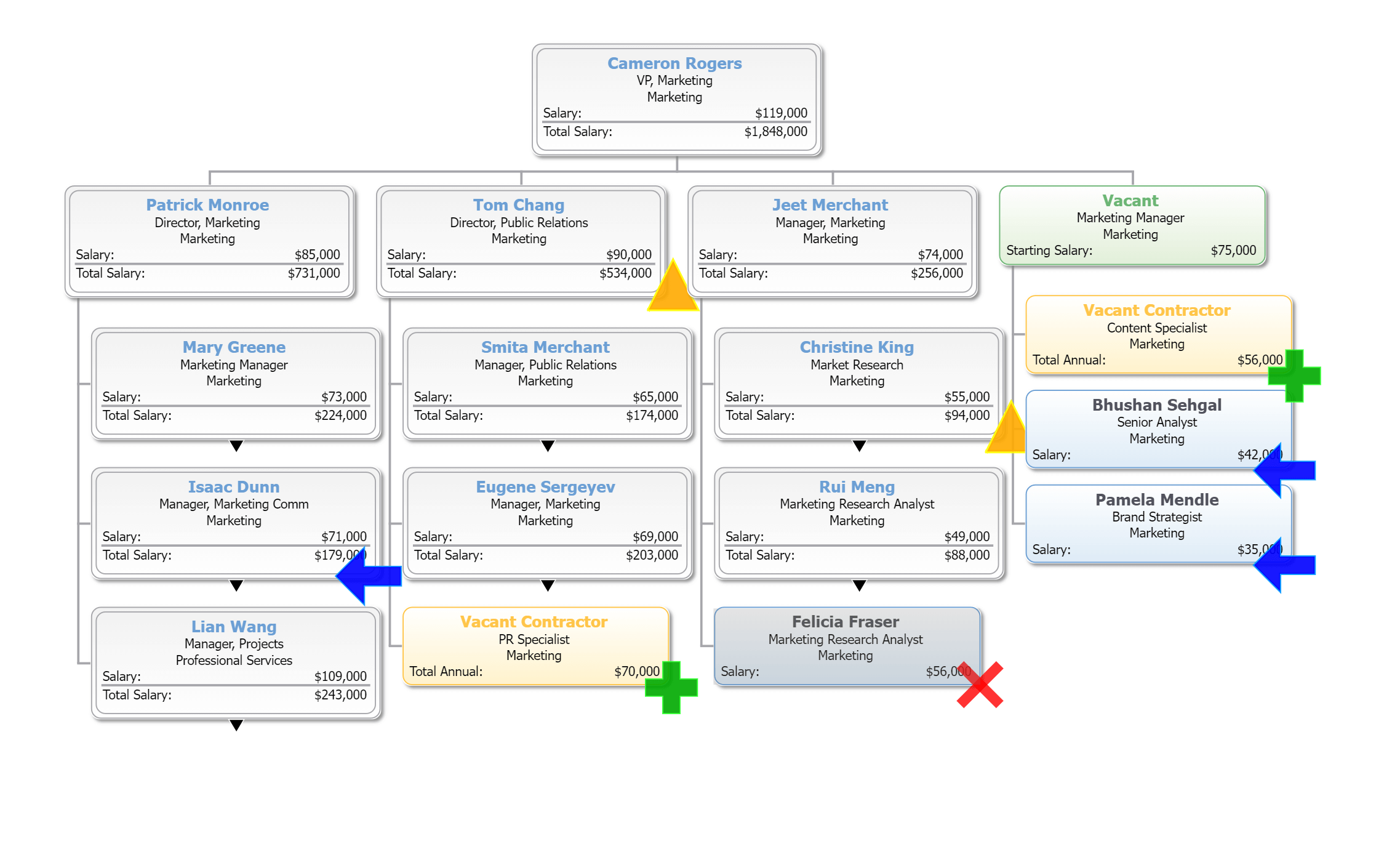December 19, 2023
8:34 PM
By OrgChart Team

Most leaders understand that a company’s organizational structure plays a pivotal role in defining its efficiency, strategic direction, and culture. While employees may not think of their organizational structure often, they do feel the effects of the company hierarchy, whether it’s highly functioning or misaligned and clunky.
When it comes to Software as a Service (SAAS) organizational structure, it’s no different. In fact, because SAAS companies are known for their innovation and collaboration, it’s even more important for SAAS leaders to intentionally map and plan roles and responsibilities.
Below, we break down SAAS company org charts and uncover the nuances that define their functionality and effectiveness.
SAAS organizational structure refers to the specific ways in which the teams and departments within a SAAS company are organized and interact to achieve the company’s goals. These structures are designed to optimize efficiency, collaboration, and innovation in delivering software solutions to customers through a subscription-based model.
Below are a few key components of SAAS organizational structures and their general methodologies:
Principles: Flexibility, adaptability, continuous improvement.
Benefits: Enables quick adaptation to changing market conditions, enhances collaboration, and fosters a culture of continuous innovation.
Application: Reflected in the organizational design to ensure responsiveness to dynamic industry demands.
Culture: Fosters a culture of innovation by encouraging cross-functional collaboration.
Approach: Org chart facilitates idea exchange, breaks down silos, and promotes collaboration at all levels.
Examples: Companies like Slack and Zoom exemplify successful innovation through collaborative organizational approaches.
Startups: Flat structures, cross-functional teams, emphasis on agility and innovation.
Mid-sized Enterprises: More specialized roles, departmentalization, and structured approach to scaling operations.
Large Corporations: Hierarchical structures, distinct layers of management, and specialized departments for different product lines or regions.

Org charts serve as more than just visual representations of hierarchical structures for SAAS companies. They are also instrumental in fostering a culture of innovation, collaboration, and growth.
Because most SAAS companies nurture creativity and collaboration, their digital company org chart must contain essential components for sustained success.
SAAS companies recognize that innovation is not confined to a single department but a collective endeavor. Their org chart serves as a blueprint for fostering an innovation-centric culture. By encouraging cross-functional collaboration, breaking down traditional silos, and providing channels for idea exchange, the org chart becomes a catalyst for creative thinking at every level.
Collaboration is the backbone of SAAS company culture. Organizational structures are therefore designed to facilitate seamless communication and cooperation among diverse teams. Whether it’s the product team working hand-in-hand with marketing to align features with market needs or customer support providing valuable insights to guide future innovations, the org chart serves as a roadmap for collaborative efforts.
Many SAAS firm hierarchies aren’t set in stone. Instead, SAAS culture usually pivots and experiments with everything from org structure to market strategy.
One of the key considerations in SAAS organizational design is scalability. An effective org chart reflects the company’s capacity to scale, adapt, and maintain a competitive edge in the SAS world. This adaptability ensures that the organizational structure remains a strategic asset, aligning with the company’s goals and facilitating sustained growth.
Agile methodologies prioritize flexibility, adaptability, and continuous improvement, aligning seamlessly with the fast-paced nature of SAAS development. There are many benefits SAAS witness when they incorporate agile principles into their org structure, including:
Companies like Salesforce and Atlassian have embraced agile principles with notable success. Salesforce, a SAAS giant, leverages agile to continually refine its customer relationship management (CRM) solutions, ensuring they remain adaptive to evolving business needs. Atlassian, known for its collaboration tools, attributes much of its innovation and speed to market to agile methodologies, enabling them to stay at the forefront of the SAAS industry.
Like all organizations, every single department and person is important within a SAAS company. However, several key teams collaborate to drive success within the SAAS world, and that ongoing communication – made possible with quick access to essential people-related information – is critical to move companies forward.
Roles: Software developers, engineers, architects.
Responsibilities: Creating, maintaining, and enhancing the software infrastructure of the SAAS product.
Interaction: Collaborates closely with product management to bring features to fruition and ensures the technical excellence of the product.
Roles: Product managers, product owners.
Responsibilities: Defining the product roadmap, prioritizing features, and aligning the product with market needs.
Interaction: Works closely with development, sales, and marketing teams to ensure the product meets customer expectations and market demands.
Roles: Sales professionals, marketers.
Responsibilities: Introducing and promoting the SAAS product, engaging with potential clients, and creating brand awareness.
Interaction: Collaborates with product management to understand customer needs, tailors marketing strategies, and supports the sales process.
Roles: Customer support representatives, technical support.
Responsibilities: Addressing customer queries, resolving issues, and providing assistance to ensure customer satisfaction.
Interaction: Provides valuable feedback to the development team for product improvement and collaborates with sales and marketing to enhance customer relationships.
By understanding the distinct roles and interactions of these core teams, leaders can gain better insight into their collaborative workforce and deliver solutions that positively affect every employee.
It’s important to note that SAAS org structures aren’t a one-size-fits-all proposition. Rather, the digital company org chart adapts and evolves based on the size and scale of the organization, which is why it’s critical to choose a solution that is customizable to unique structures and needs.
In the early stages, SAAS startups often sport a flat organizational structure. Teams are small and cross-functional, fostering direct communication and rapid decision-making. The focus is on agility and innovation, with employees wearing multiple hats to address the diverse needs of a budding company.
As SAAS companies grow, they typically experience a shift towards more specialized roles and departmentalization. The org chart becomes more layered, with dedicated teams for development, marketing, sales, and customer support. This transition allows for a more structured approach to scaling operations and managing increased complexity.
For large SAAS enterprises, organizational charts take on a hierarchical form with distinct layers of management. Specialized departments become more pronounced and there is a greater emphasis on delineation of responsibilities. Large companies often have separate teams for different product lines or regional markets, contributing to a complex yet well-coordinated organizational structure.
Agile methodology, collaboration, and scalability wouldn’t be possible without transparency.
A transparent organizational structure is key to aligning teams, promoting collaboration, and facilitating informed decision-making. As the SAAS industry continues to evolve, embracing transparency becomes a strategic imperative for sustained success.
At OrgChart, we take transparency seriously. Our platform seamlessly integrates with your HR data and ATS to give you visibility into your workforce. With people data at your fingertips, you’re able to make informed decisions on any gaps, trends, and opportunities. The result? Gain visibility into your workforce, encourage collaboration across teams, and set your organization up for future success.